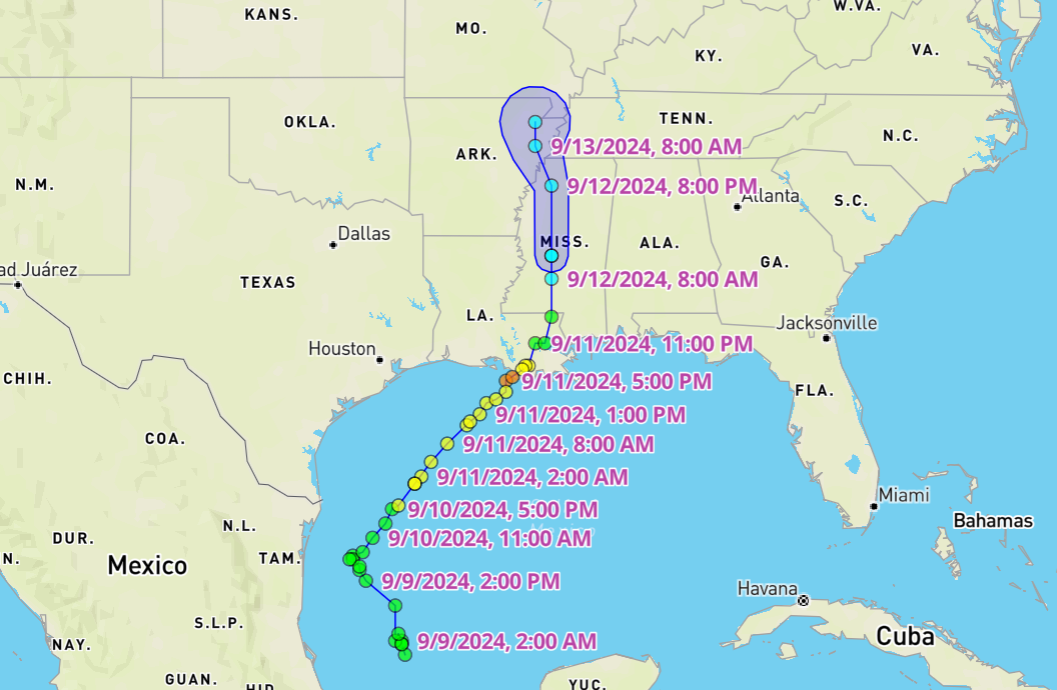We followed Tropical Storm Francine from her infancy, and as expected, it hit Louisiana as a Category 2 hurricane. The Louisana coast is a dangerous place to take up residence if you are allergic to storm surges. It floods quickly and often, so the media can’t resist the urge to break out the climate hyperbole.
CNN seemed like the most sensible stooge to fisk, and their reporting starts out with the basics: flooding. 400,000 are without power. Schools and transportation are disrupted. They reported the tornado threat in and around Louisiana, Mississippi, and the Florida Panhandle. It is all very balanced, but they venture into what I’d like to call climate clown school territory.
In 2020, Hurricane Laura ravaged Lake Charles in southwest Louisiana. The Category 4 storm’s ferocious winds flattened homes, toppled large vehicles, uprooted trees, left many residents without power and took at least six lives. Weeks later, Hurricane Delta left a trail of destruction in the area, followed by a deadly ice storm later that winter.
Just a year later [2021], Category 4 Hurricane Ida threw southern Louisiana into a similar chaos — except it wreaked havoc on the more populated areas in and around New Orleans. Ida dumped more than 10 inches of rain across parts of the Gulf Coast and generated a storm surge as high as 14 feet. …
Hurricanes Laura and Ida were tragic examples of how human-caused climate change is making hurricanes more dangerous, and they made lasting impressions on the state and left its residents and infrastructure vulnerable to repeat damage and farther away from recovery.
Nineteen recorded category 2 hurricanes hit Louisana in the 19th and 20th centuries, ten in the 1800s (1860-1893), and nine in the 1900s. Only two have made landfall there since 2000, the last three years ago.
Nineteen Category 3 Hurricanes landed in the Bayou state in the 19th and 20th centuries. Six in the 1800s (1852-1893) and 10 in the 19th century. Three Cat 3s have landed there in the 21st century, but there have been none since 2020.
There was one Cat 4 reported in 1856 and three in the 20th Century. The two storms CNN mentions are from 2020 and 2021 but none since then.
The only recorded Cat 5 hurricane to strike Louisana was in 1969.
Global Warming was invented in 1984, and since then, the majority of storms landing on the Louisiana coast have been Cat 2 or less.
There have been three hurricane landfalls in the US this year. Beryl* and Deby were Cat 1 upon landfall, and Francine was Cat 2 for less than two hours. (Beryl* was Cat 5 in the Caribbean.)
| Sep 11 | 17:00 GMT | 28.3 | -92.3 | 90 mph | 976 mb | Hurricane | 1 |
| Sep 11 | 18:00 GMT | 28.6 | -92.1 | 90 mph | 976 mb | Hurricane | 1 |
| Sep 11 | 19:00 GMT | 28.7 | -91.8 | 90 mph | 976 mb | Hurricane | 1 |
| Sep 11 | 20:00 GMT | 28.9 | -91.5 | 90 mph | 975 mb | Hurricane | 1 |
| Sep 11 | 21:00 GMT | 29.2 | -91.5 | 100 mph | 972 mb | Hurricane | 2 |
| Sep 11 | 22:00 GMT | 29.3 | -91.3 | 100 mph | 972 mb | Hurricane | 2 |
| Sep 11 | 23:00 GMT | 29.5 | -91 | 90 mph | 975 mb | Hurricane | 1 |
| Sep 12 | 00:00 GMT | 29.6 | -90.9 | 85 mph | 978 mb | Hurricane | 1 |
| Sep 12 | 01:00 GMT | 29.6 | -90.8 | 75 mph | 980 mb | Hurricane | 1 |
| Sep 12 | 03:00 GMT | 30.2 | -90.6 | 70 mph | 982 mb | Tropical Storm | — |
In other words, the evidence suggests that human-caused climate change, as defined by CNN and company, is reducing the frequency and severity of storms landing in Louisiana—but not just there.
Globally, total cyclonic energy has declined since Global Warming was invented.

As has the number of strong storms (CAT 3+), which is why we expected this year to be explosive.

That has yet to happen, but as Francine dies over the American midwest, there are three more disturbances, one of which is already looking like it will be name-worthy before the weekend. And we are due for a cyclic upswing (that has nothing to do with the approved climate change narrative)
To be clear, none of this is meant to diminish the impact of any storm or the disruption to livelihoods and lives wherever tropical storms and hurricanes land. But Louisiana gets hurricanes, the Midwest gets tornadoes, the Northeast gets massive blizzards, and Southern California is a desert prone to prolonged drought, among other issues. We choose to live where we are or have to accept the cards we’re dealt.
CNN is trying to stack the deck, and while we don’t expect better from them, the actual data—which is easy to find—does not support the approved narrative. Loisiana is not experiencing more storms and more severe storms—quite the opposite.
If CNN told the truth, billions of dollars might be freed up annually to address real needs and problems instead of fake ones that make energy more expensive for the very people CNN claims to champion.
